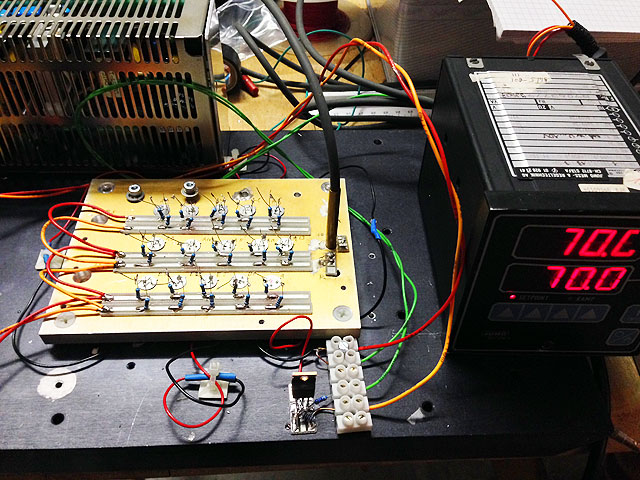
Return to home page

Pic: Accelerated aging on hot plate
2) Temperature Coefficient TC0
This is a slowly ongoing project that ties together various kind of interesting electronics. The issue is to create a voltage/current reference with lowest practically possible noise. This is motivated in part by a long term project to develep a cheap, stable and low noise current driver for laser diodes (to complement my Arduino based TEC controller).
It was mainly motivated by the discussions at eevblog on the Chinese super-low noise Zener diodes 2DW23x. This is kind of a sweet electronics challenge and so I had to get a few of those to play around with. I won't add a lot on top of what has been discussed there by very competent people, except I may incrementally add a few observations and findings of from time to time.
General remarks: it seems that there are many different brands of this diode on the market. I sampled a variety from different sellers at Aliexpress and also from various offers at eevblog. Upshot: Forget any diode without a "diamond" logo, or with golden legs. Forget also the precise denomination 2DW232..236, as there seems no discernible distinction. But even with the "diamond" logo there are at least two different kinds, one which shows no date label, and one with date label (the ones I got with date labels are very similar). Let's denote them by "BatchA" and "BatchB" as follows:
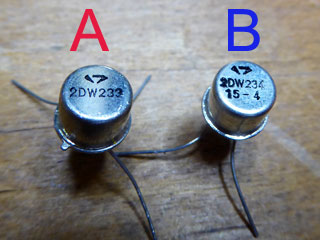
There are three important properties of a Zener diode with regard to application as a reference: temperature coefficient (TC), noise, and long term stability. I was and am spending quite some time in measuring these for a selection of like 40 diodes. Below the upshot. More data will be added incrementally over time.
2) Temperature Coefficient TC0
There is a current range for which the temperature coffecient is low and actually turns through zero at a relatively narrowly defined current. The 2DW23x Zeners have two diodes back-to-back, which gives alltogether 4 possibilites: 2 from using the single Zeners ("single diode config"). and 2 from using one Zener forward and one backwards ("series diode config"). For single config the Zener voltage is around 5.4V and the series config about 6.2V. The series config has the advantage that the range for small TC is broader and occurs at a higher current (where the noise is lower). It turns out, not suprisingly, that for any given sample, there is no significant difference in the data between the two single and the two series configurations, respectively.
I was aiming for a TCO temperature slightly above room temperature, say around 30C, and the associated current was found to vary between approx 10 and 40 mA (for series configuration), even for diodes from the same batch. And it seems absolutely independent from the precise denomination 2DW232..236. Here a summary for various diodes:
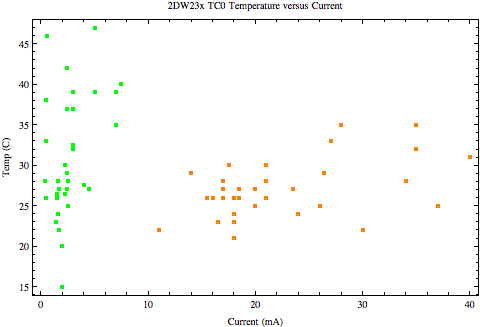
Orange dots: series diode configuration, green dots: single diodes.
The actual temperature value for vanishing temperature coefficient ("TC0 point") varies dramatically with the current. Here are typical results that illustrate what I mean:
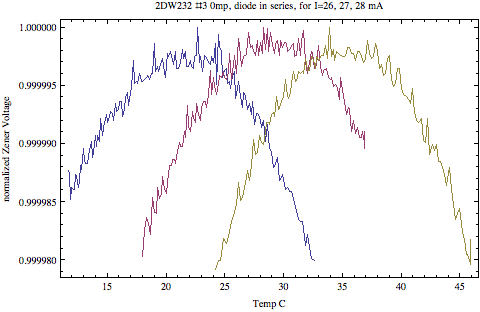
Shown above are TCO sweet spots for series configuration, for normalized Zener voltages, for three different currents. Similar for single diode configuration:
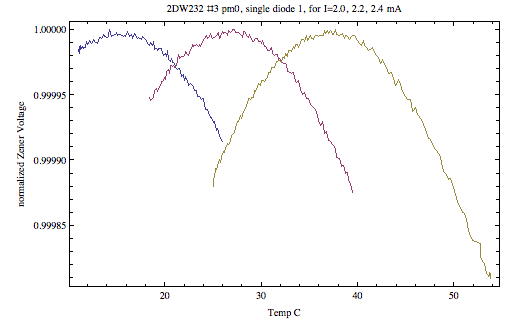
Here a comparison of single/series diode configurations, which shows that the series configuration has a considerably broader range of small TC:
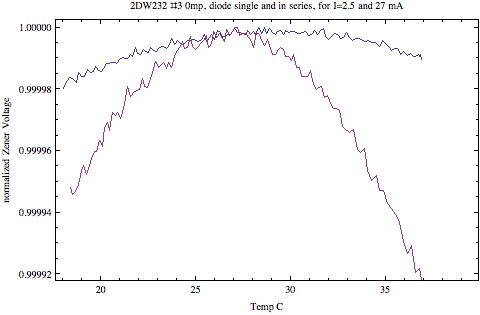
We see that the TC0 temperature itself varies strongly with the current (about 20C span for a 10% change in current). In practice this means that it is difficult to find a sweet spot in an ad hoc fashion, since it can be anywherere between 10 and 40mA or so (for series configuration), and you must hit within about 10% of its value. So I automatized a systematic temperature/current scanning by using my Arduino based TEC controller in combination with a LabVIEW interface:
Click for enlargement.
The most interesting feature of these diodes, namely that they can have almost incredibly low noise, was pointed out at eevblog here and here. It can come down to much less than 1uVpp for 0.1-10Hz bandwidth, which beats even the best reference diodes on the market, such as the LTZ1000 . This is in principle interesting for me with my quest to build an ultra-low noise laser diode driver. So I had first to build suitable low noise preamplifiers to test various samples; these are described here.
I found that the noise properties depend strongly on the particular batches. Below an overview:
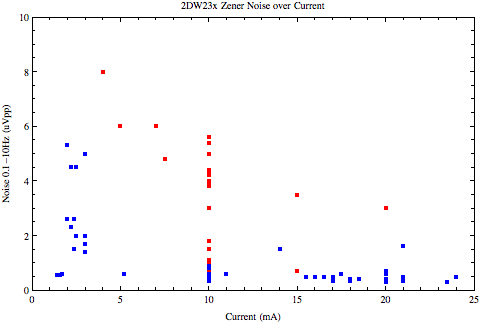
Red dots: batch A, blue dots: batch B (currents at 10mA and above refer to series diode config). Clearly batch B has in average substantially lower noise than A. Actually I have dropped from the plot a few outlier cases at 15, even 20uV, from batch A. So, at any rate we see that individual testing is necessary, if noise is an issue at all.
Here a sample shot, which shows noise of 300nVpp at 0.1-10Hz bandwidth (100mV corresponds to 1uV):
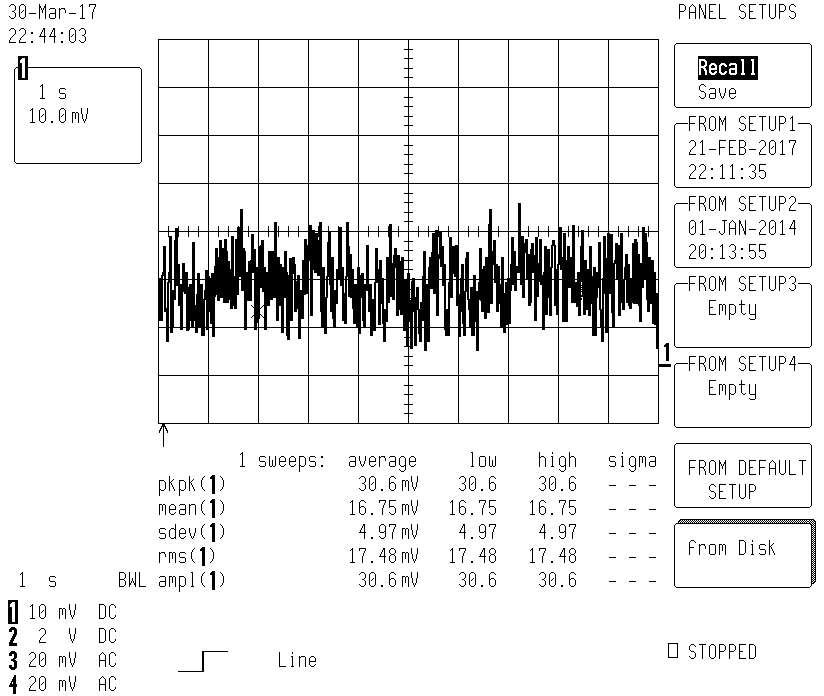
Note that my amplifier itself has noise of about 200-250nVpp, so the diode noise has definitely lower than 300nVpp.
![]()
Important is of course also the long-term drift of Zener voltage. Since there is no reason why it should be low for such cheap diodes, there could be bad surprises. Unfortunately this is a very lengthy process that takes thousands of hours burn-in time. I intend to add here results here and then when they arrive.
I intend to run a collection of diodes for half a year or so, under accelerated aging conditions, using a temperature controlled Peltier hot/cold plate. Initially at 70C, now at 50C but with current of 30mA through each diode; sometimes changing polarity plus one temperature cycling per day. Here a pic of the setup that is constantly running:
After 4 months of continuously running under these conditions, here are first results:
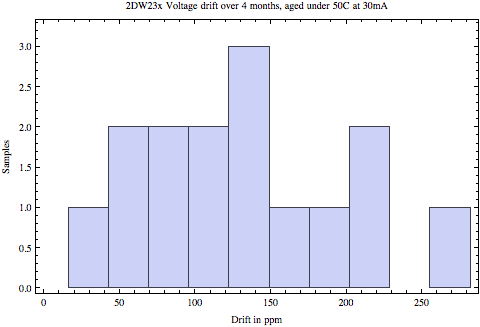
Here to gauge future long-time trends:
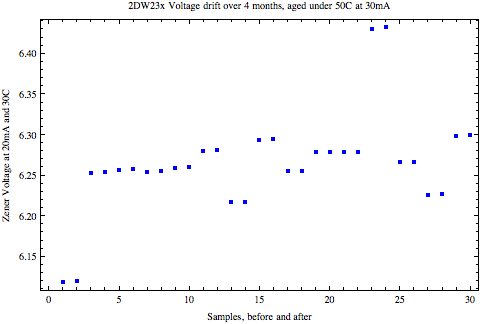
Current: Vers. 1.1 09-2017
Return to home page